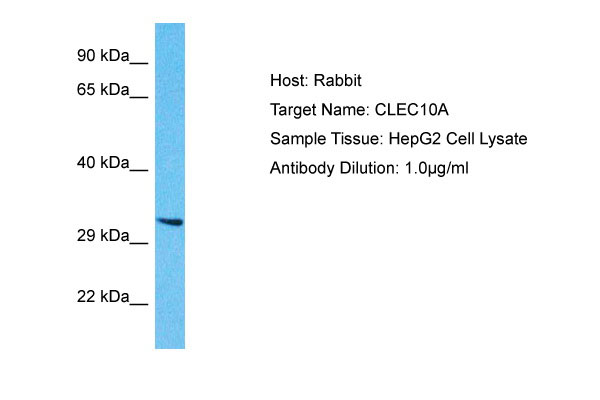CLEC10A Antibody - N-terminal region
Rabbit Polyclonal Antibody
- 产品详情
- 实验流程
Application
| WB |
|---|---|
| Primary Accession | Q8IUN9 |
| Other Accession | NP_878910 |
| Reactivity | Human |
| Host | Rabbit |
| Clonality | Polyclonal |
| Calculated MW | 35446 Da |
| Gene ID | 10462 |
|---|---|
| Alias Symbol | CLEC10A, CLECSF13, CLECSF14, HML, |
| Other Names | C-type lectin domain family 10 member A, C-type lectin superfamily member 14, Macrophage lectin 2, CD301, CLEC10A, CLECSF13, CLECSF14, HML |
| Format | Liquid. Purified antibody supplied in 1x PBS buffer with 0.09% (w/v) sodium azide and 2% sucrose. |
| Reconstitution & Storage | Add 50 &mu, l of distilled water. Final Anti-CLEC10A antibody concentration is 1 mg/ml in PBS buffer with 2% sucrose. For longer periods of storage, store at -20°C. Avoid repeat freeze-thaw cycles. |
| Precautions | CLEC10A Antibody - N-terminal region is for research use only and not for use in diagnostic or therapeutic procedures. |
| Name | CLEC10A {ECO:0000303|PubMed:33724805} |
|---|---|
| Function | C-type lectin receptor involved in recognition of N- acetylgalactosamine (GalNAc)-terminated glycans by myeloid antigen presenting cells (APCs) (PubMed:15802303, PubMed:16998493, PubMed:17616966, PubMed:22213806, PubMed:33724805, PubMed:8598452). Binds in a Ca(2+)-dependent manner to alpha- and beta-linked GalNAc residues on glycoprotein and glycolipid antigens, including alphaGalNAc- and Galbeta1->3GalNAc-O-Ser/Thr also known as Tn and T antigens, LacdiNAc epitope GalNAcbeta1->4GlcNAc and its derivative GalNAcbeta1->4-(Fucalpha1->3)GlcNAc, O-linked core 5 and 6 glycans, and GM2 and GD2 gangliosides (PubMed:15802303, PubMed:23507963). Acts as a signaling receptor at the interface of APC-T cell interactions. On immature dendritic cells, recognizes Tn antigen-carrying PTPRC/CD45 receptor on effector T cells and downregulates PTRPN/CD45 phosphatase activity with an impact on T cell activation threshold, cytokine production and proliferation. Modulates dendritic cell maturation toward a tolerogenic phenotype leading to generation of regulatory CD4- positive T cell subset with immune suppressive functions (PubMed:15802303, PubMed:16998493, PubMed:22213806). Acts as an endocytic pattern recognition receptor involved in antitumor immunity. During tumorigenesis, recognizes Tn antigens and its sialylated forms Neu5Ac-Tn and Neu5Gc-Tn expressed on tumor cell mucins. On immature dendritic cells, can internalize Tn-terminated immunogens and target them to endolysosomal compartment for MHC class I and II antigen presentation to CD8-positive and CD4-positive T cells, respectively (PubMed:15802303, PubMed:17616966, PubMed:17804752). |
| Cellular Location | Cell membrane; Single-pass type II membrane protein. Early endosome membrane; Single-pass type II membrane protein Lysosome membrane; Single-pass type II membrane protein. Note=Recycles between the plasma membrane and the endolysosomal compartment. Upon antigen binding, internalizes via endocytosis and then dissociates from antigen at acidic pH characteristic of endolysosomal vesicles |
| Tissue Location | Expressed in myeloid antigen presenting cells in lymph nodes and skin (at protein level). Expressed in dermal dendritic cells (at protein level). |
Research Areas
For Research Use Only. Not For Use In Diagnostic Procedures.
Application Protocols
Provided below are standard protocols that you may find useful for product applications.
REFERENCES
Suzuki N.,et al.J. Immunol. 156:128-135(1996).
Ota T.,et al.Nat. Genet. 36:40-45(2004).
终于等到您。ABCEPTA(百远生物)抗体产品。
点击下方“我要评价 ”按钮提交您的反馈信息,您的反馈和评价是我们最宝贵的财富之一,
我们将在1-3个工作日内处理您的反馈信息。
如有疑问,联系:0512-88856768 tech-china@abcepta.com.























 癌症的基本特征包括细胞增殖、血管生成、迁移、凋亡逃避机制和细胞永生等。找到癌症发生过程中这些通路的关键标记物和对应的抗体用于检测至关重要。
癌症的基本特征包括细胞增殖、血管生成、迁移、凋亡逃避机制和细胞永生等。找到癌症发生过程中这些通路的关键标记物和对应的抗体用于检测至关重要。 为您推荐一个泛素化位点预测神器——泛素化分析工具,可以为您的蛋白的泛素化位点作出预测和评分。
为您推荐一个泛素化位点预测神器——泛素化分析工具,可以为您的蛋白的泛素化位点作出预测和评分。 细胞自噬受体图形绘图工具为你的蛋白的细胞受体结合位点作出预测和评分,识别结合到自噬通路中的蛋白是非常重要的,便于让我们理解自噬在正常生理、病理过程中的作用,如发育、细胞分化、神经退化性疾病、压力条件下、感染和癌症。
细胞自噬受体图形绘图工具为你的蛋白的细胞受体结合位点作出预测和评分,识别结合到自噬通路中的蛋白是非常重要的,便于让我们理解自噬在正常生理、病理过程中的作用,如发育、细胞分化、神经退化性疾病、压力条件下、感染和癌症。






